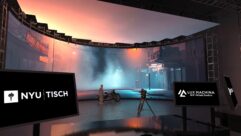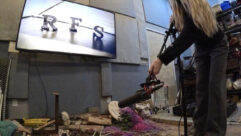Take the A Train
Jul 1, 2003 12:00 PM,
Rosanne Soifer
The 5:06 train to Lynbrook is now departing from Track 2 … because of ongoing track work, the D train to Coney Island will be making express stops only … please have your boarding passes ready for the 7:50 Acela Express to Washington, D.C.…
These messages, and many more like them, guide travelers through New York City’s rail transit: the MTA subways, the Long Island Rail Road, Metro North, and Amtrak. The voices are synthesized, and the visuals are digital state of the art. Gone (mostly) are incomprehensible announcements over a squawking P.A. system, printed schedule changes that end up as litter, and numerous information personnel.
With more and more options in compact audio and video systems, the messaging and signage market in the field of rail transportation has exploded. Along with New York City, digital and animated signage has been embraced by cities with sophisticated rail centers, such as San Francisco and Washington, D.C. The San Francisco BART system is in the preliminary stages of incorporating Sony’s new NSP-100 Network Player, a new appliance that receives audio, video, text, and graphics as files over IP networks.
I took a brief look at digital and animated signage in several transportation centers around New York City, where it is utilized for both commercial purposes and traveler information.
NARROWCASTING
Some preliminary information may be in order. The point of outdoor animated and digital signage is to intercept targeted customers during their daily travel. According to Tim Stauning, president of Clear Channel Outdoor, commercial digital and animated signage arrived in New York City about five years ago around the Times Square area. “This was a first-time street-level animation package within a city environment,” he says. (There was — and still is — no audio component because it’s impractical.) A demonstration model of Clear Channel’s display is on the northeast entrance to the 23 Street Station, featuring fashion, retail, and entertainment content. Clear Channel Outdoor provides the content as a licensee of the NYC Transit Authority. (Currently, the company rents about 900 subway spots for traditional billboards.)
When a commercial product display is located in a commuter rail center, there are several benefits, according to Clear Channel Outdoor:
- it reaches a captive, generally upscale commuter, in addition to lunch-time patrons, shoppers, and business professionals;
- it offers face-to-face impact in high-traffic corridors;
- it delivers messages in an uncluttered, visually stimulating environment; and
- it provides impressions in upscale areas often unreached by traditional out-of-home displays.
This is unlike a print ad for shampoo in a magazine. Although the magazine’s readership may be targeted to, say, teenagers, the same product may appear in other magazines aimed at other audiences. The magazines’ readers may not be able to immediately purchase shampoo when they see the ad. But what if the ad is placed near a store where the shampoo is sold?
This is an example of the term narrowcasting. California Polytechnic State University of San Luis Obispo provides a good definition as part of its online tutorial on media. “Narrowcasting is a term opposite of broadcasting,” it states. “It refers to information, programming, or advertising that is directed to a highly specific segment of the public. Networks engage in narrowcasting when they take into consideration who will be watching programs from Sesame Street to Dateline.” Unlike family-hour sitcoms, these shows don’t intend to catch the entire viewing public, only a specific part.
CAP Ventures — an online consulting firm in Norwell, Massachusetts — says four types of narrowcasting are seen in public spaces:
- point-of-purchase;
- visual merchandising;
- out-of-home advertising; and
- interactive hybrids that combine the first three.
Specific messaging and signage used in transportation may also fit the definition of narrowcasting, because it offers specific information to a basically captive audience.
The field of continually updated traveler information, transmitted electronically, probably started on radio in the late 1970s with traffic reports. According to ITS Online, Kenneth Orski (who publishes Innovation Briefs, a Washington, D.C.-based newsletter) says travelers overwhelmingly preferred radio to any other medium (including television) for traveler information. After all, most people stuck in traffic are generally in their cars, most of which have a radio. The average car doesn’t yet come with Internet access or TV.
Yet information at rail transit hubs may combine audio, visual signage that includes pictures and instant messaging, and the ability to provide a steady flow of changing information. An example is the Talking Kiosk for the visually impaired at the Long Island Rail Road Terminal at Penn Station in New York City, which combines a tactile and large-print map with a talking computer that responds when points on the map are pressed.
The locomotive of the Amtrak Acela Express train from New York City to Washington, D.C. resembles a spaceship. There are no more oversized hand controls, quaintly lettered signs and posters, and engineers wearing striped overalls. Locomotive engineer Ike Nahem says that the trains became high tech a few years ago but with live announcements by train personnel rather than synthesized audio playback. Amtrak’s passenger waiting area has also changed. A huge digitalized signage board hangs in the center and posts departure times, track numbers, destinations, and status. Absent are the “flip” boards, printed schedules (a sign outside a ticket window directs you to the Amtrak Web site for complete schedules), and a staffed centralized information booth. (Absent, too, are places to sit down. Unless you’re a ticketed passenger, you’re not allowed in the lounge. The Long Island Rail Road’s passenger area in Penn Station is similar. Technology has generally made passenger services and information more efficient by cutting down on paper and railroad personnel; nevertheless, a byproduct was doing away with comfort.) Comfort, however, is usually not on anyone’s mind when they ride the New York City subway system. On-time service, reliable information, and possibly the new fare hike, are. Says Charlie Seaton, spokesperson for New York City Transit, “A subway car lasts about 40 years, and we just put in about 6,000 new ones. One thousand three hundred of them (the R142, R142A, and the R143) are integrated with digital signage.”
Tom Bianco, the R143 systems integrator, says only a few cars on the IRT line still have the nondigital “roll” origin/destination signs. “But each new car has several signs: two ceiling, one side interior, one side exterior, the train line symbol at both ends of the car, the time, immediate destination, and final destination,” he says. The sign assemblies are made by Kawasaki. It subcontracted out some of the electronics to Luminor and Felicite, and Telephonic provided the communication system. “The audio system in the signage plays a prerecorded message at each stop that states transfer points and cautionary information,” Bianco says. “All are computer controlled, programmable, and updateable — what we call a smart sign.”
Another provision in the new cars are wall intercoms, Seaton says. “Riders can communicate with the train crew for emergencies, and the train crew can communicate privately with each other,” he says.
How can an independent get involved in the signage market? A state or citywide transit system and large retail chains will automatically deal with huge companies and manufacturers. One way, says Russ Dubrow — president of Electronic Technology in Lomita, California — is to set your sights on small, self-contained jobs first. “Get involved with little jobs like [independent] retail applications, clothing stores, independent music stores, car dealerships, sporting goods stores, etc.,” Dubrow says. “The selling of signage is not as big of a deal as it is trying to captivate the audience regardless of sex, age, and demographics, etc. Content providers are at least 90 percent of the issue when selling signage.”
Rosanne Soiferis a musician and writer based in New York. She may be reached at[email protected].
Signage Up Ahead
Other points to consider:
- Find out your potential client’s software programming needs for signage and messaging. If you can’t land the whole job yourself, perhaps the client will outsource some programming work to you as an independent contractor.
- If you’re interested in transportation, look toward small “enclosed” environments containing roads and parking, such as community colleges, private schools, gated communities, and golf and country clubs.
- For signage in commercial applications, be aware that the message needs to be short and to the point. Unlike animated signage in theme parks and nightclubs, which can morph into electronic works of art with music accompaniment, point-of-sale signage has one goal: to grab a potential customer and grab him or her fast.
- Determine the average length of time someone will spend reading the information before you present the client with movie-length visuals. Obviously, someone leisurely shopping in a mall will have more time than someone driving around the winding roads of a gated community in a rainstorm.
- How often will the information have to be updated, and what are the mechanics of doing so? Is enough basic information included — perhaps to lessen client liability — but not so much that the purpose of the signage is defeated? Russ Dubrow of Electronic Technology says that in the case of a car dealer, interest rates (for dealer financing) must contain a fair amount of information and need to be updated pretty regularly.
- For an area such as a school or a gated community, be aware that the local municipality may have traffic ordinances relating to signage content, height, permits, foliage, expiration dates, and so on that supercede those of your client. Research these items (especially any required permits) and factor them into your proposed budget.
- Become cognizant of any copyright/trademark issues that may relate to the content your client wants shown. This may be particularly important to a retail operation that sells many brand names.
TR Technologies
Ted Rothstein is the owner and president of TR Technologies, a New York City-based company that has done extensive digital signage work. The company recently completed ten W Hotels for the Starwood Group — five in Manhattan, two in New Orleans, two in Chicago, and one in Los Angeles. Rothstein developed a high-definition rear-projection video system for Times Square that receives broadcasts from a satellite dish 60 floors above.
Soifer: How did you get involved in doing animated and digital signage?
Rothstein: Planet Hollywood wanted to add logos and other info to its media presentations. I created images showing something from the movie that used the audio track being heard at that moment, so the listener would remember the film that used that particular musical track. This image played on the video screens for the first 50 percent of each audio-only track that was used in a movie. An animated logo played on the video screens during the second 50 percent of each audio-only track. I designed and coded a computer system (C++) to control and synchronize the music, the videos, and the various logos and images.
Soifer: A large system [like the MTA or BART] isn’t going to hire a small operation for signage. What are more manageable potential clients — clubs, small colleges, apartment complexes, and gated communities?
Rothstein: Those sound like reasonable clients for digital signage. I wouldn’t expect someone to come to me for signage only. It would typically be an extra I can offer as part of an A/V system.
Soifer: When dealing with the companies that make the actual signage as well as the electronic components, are you a subcontractor or simply the purchaser of the materials?
Rothstein: Clients often think they can get the equipment for free in trade for the trademark of the manufacturer being seen on the product. I’m more interested in the clients that realize that need to own the hardware, and I expect to sell it.










